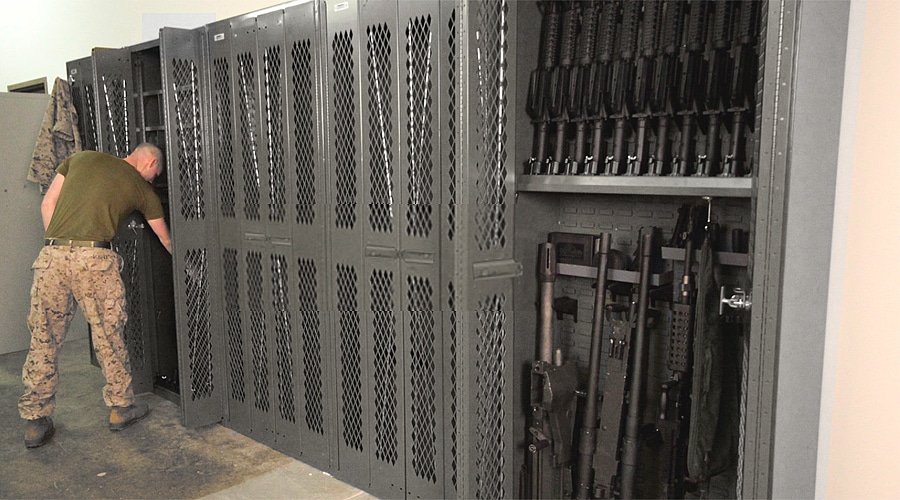Weapon Storage: 4 Things You Need to Know

Understanding Modern Weapon Storage.

The 4 Basic rules for a functional armory
- Weapon Racks are designed to store weapons not gear
Gear storage is a growing problem. The volume of serialized and high value gear going into armories is increasing. Weapon racks do not properly store this gear and results in high damage and loss rates as well and poor inventory/audit function. Serialized gear should be stored in steel drawer cabinets with adjustable dividers. - When working with a supplier to upgrade your armory make sure they know what they are doing
Most of the problems related to bad or inefficient weapon storage systems and armories trace back to inexperienced or negligent distributors and sales representatives. Make sure the salesman talking to you about storage knows what he is doing.
If the supplier’s main business is office and filing solutions or focused on industrial warehouse storage, then you need to ask them a few qualifying questions. see: Evaluating the competence of your sales-rep - Do you really need a high density mobile aisle storage system?
We see a lot of these systems being installed. In many cases, they are the wrong choice. While these systems can save a lot of space, there are serious workflow and ergonomic issues to be considered. This takes us back to making sure your sales rep is experienced. See: Understanding High Density weapon Storage - Keep it simple
Complexity is perhaps the biggest problem we see in weapon storage armories today. Current manufacturers have taken the concept of flexible weapon storage that we outlined in our brief to USAFC 10 year ago, way off the deep end. (see Arms room assessment )Many weapon racks on the market today have so many brackets and different parts they are simply are not stable storage platforms.
Why this is important
In the last few years, several office and filing storage manufacturers have entered the weapon storage rack market. These companies do not appear to have any real experience in this field. The storage systems they are representing or manufacturing simply do not work well in military armories. In order to make a proper decision, it is critical that armorers, commanders and contracting officers involved in the procurement of new equipment understand the basics of modern weapon storage and the pitfalls of doing it wrong. I have been brought in on many armory redesigns to fix issues that occurred after a new system was installed. While a new weapon storage system may look great on CAD drawings or a fancy proposal, proper armory weapon storage is a function of system design and flexibility matching the armory’s intended use.
A Brief History

I got involved in military weapon storage in 2001 when I was running a technology storage company. I received a call from a client who asked if we could store MP5s in one of our high-security laptop storage cabinets. I was intrigued, as I looked further into military weapon storage I found that there were serious concerns and difficulties. The military was moving to modular weapon systems. These systems have a wide variety of removable optics and electronics. (AGOGs, PEQs etc.) Weapon storage systems designed for traditional battle rifles (M16, M14, M4) simply were not up to the task of storing modern weapon systems with all their modular components and parts.
It seemed that the companies supplying these solutions did not have a true understanding of the challenges and requirements of a modern armory. Most manufacturers were reacting to military weapon system changes by simply adding new components and pieces to their current rack systems. The net result, most of the weapon storage systems on the market were becoming very complex and difficult to use with the addition of specialty components and system revisions. Lots of components mean more potential problems. Unique and proprietary translates to expensive, difficult to use, and hard to adapt to a change. They limit future options and force the customer to come back to the original manufacturer when the situation changes. This course of action dramatically increases cost for long-term ownership.
When considering an armory upgrade or renovation, make sure the company you work with really knows what they are doing. Again, the biggest reason for armory failure is bad advice from inexperienced sales representatives
Also See Armory Design
Please do not hesitate to contact our Armory design group for assistance
